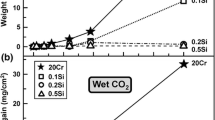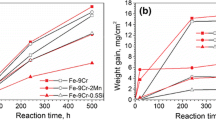Abstract
The corrosion of iron-, nickel-, and cobalt-base alloys has been studied in atmospheres containing carbon and oxygen in the temperature range 894–1366 K. It was observed that preformed Cr2O3 films are not effective barriers to carbon transport in atmospheres in which the oxide is not stable but that stable, growing Cr2O3 films are excellent barriers to carbon penetration. The presence of Fe-containing oxides on Fe-Ni-Cr and Fe-Cr alloys cause the scales to be permeable to carbon. This phenomenon was found to be sensitive to alloy surface preparation. Carbon transport through oxide scales may occur by two mechanisms: diffusion or molecular transport through physical defects. The present work has evidence of the latter but cannot rule out the former in cases where the carbon activity is sufficiently large. In gases containing CO and CO2 in which Cr carbide is stable Cr2O3 was found to form at the carbide-alloy interface by oxygen transport through the carbide. In A-CH4 Fe-Ni-Cr were found to undergo graphitization attack. The results were consistent with the formation and subsequent decomposition of metastable carbides, as proposed by Hochmann.
Similar content being viewed by others

References
A. Schnaas and J. J. Grabke,Oxid. Met. 12, 387 (1979).
J. Wada, H. Wada, J. F. Elliott, and J. Chipman,Metall. Trans. 2, 2199 (1971).
S. K. Bose and H. J. Grabke,Z. Metallkd. 69, 8 (1978).
U. Gravenhorst and W. Steinkusch,Arch. Eisenhuttenwesen,46, 397 (1975).
H. J. Grabke, U. Gravenhorst, and W. Steinkusch,Werkst. Korros. 27, 291 (1976).
O. van der Biest, J. M. Harrison, and J. Norton, “Characterization of Protective Layers Formed in Carburizing Environments” inProceeding of the International Conference on the Behavior of High-Temperature Alloys in Aggressive Environments, Petten, Holland (October 15–18, 1979).
R. Schueler, “Metal Dusting,”Hydrocarbon Process. 73–75 (Aug. 1972).
R. F. Hochman, “Catastrophic Deterioration of High-Temperature Alloys in Carbonaceous Atmospheres,” inProperties of High-Temperature Alloys, A. Foroulis and F. S. Pettit, eds. (The Electrochemical Society, Princeton, 1977), pp. 715–723.
F. S. Pettit and J. B. Wagner, Jr.,Acta. Metall. 12, 35 (1964).
R. J. Hussey, G. J. Sproule, D. Caplan, and M. J. Graham,Oxid. Met. 11, 65 (1977).
P. L. Surman,Corros. Sci. 13, 825 (1973).
P. L. Surman,Corros. Sci. 13, 113 (1973).
H. Meurer and H. Schmalzried,Archiv. Eisenhuttenwsen,42, 87 (1971).
L. D. Kramer and G. Simkovich,Oxid. Met. 6, 91 (1973).
A. M. Pritchard, J. E. Antill, K. R. J. Cottell, K. A. Peakall, and A. E. Truswell,Oxid. Met. 9, 181 (1975).
G. B. Gibbs,Oxid. Met. 7, 173 (1973).
F. S. Pettit and J. B. Wagner, Jr.,Acta Metall. 12, 41 (1964).
C. S. Giggins and F. S. Pettit,Oxid. Met. 14, 363 (1980).
F. A. Prange,Corrosion,15, 619 (1959).
F. Eberle and R. D. Wylie,Corrosion,15, 622 (1959).
W. B. Hoyt and R. H. Caughey,Corrosion,15, 627 (1959).
P. A. Lefrancois and W. B. Hoyt,Corrosion,19, 360 (1963).
J. D. Noden, C. J. Knight, and M. W. Thomas,Brit. Corros. J. 3, 47 (1963).
A. Norin,Oxid. Met. 9, 259 (1975).
J. E. Forrest, “Corrosion in Crevice and Weld Configurations in Dry Helium” inProceedings of the International Conference on the Behavior of High Temperature Alloys in Aggressive Environments, Petten, Holland (October 15–18, 1979).
JANAF,Thermochemical Tables NSRDS-NBS 37 (U.S. Government Printing Office, Washington, D.C., 1971).
S. Jansson, W. Hübner, G. Östberg, and M. DePourbaix,Br. Corros. J. 4, 21 (1969).
D. L. Douglass and J. S. Armijo,Oxid. Met. 2, 207 (1970).
L. Azaroff,J. Appl. Phys. 32, 1638 (1961).
M. G. C. Cox, B. McEnaney, and V. D. Scott,Philos. Mag. 26, 839 (1972).
F. S. Pettit, J. A. Goebel, and G. W. Goward,Corros. Sci. 9, 903 (1969).
N. Birks, inHigh-Temperature Gas-Metal Reaction in Mixed Environments, S. A. Jansson and Z. A. Foroulis, eds. (AIME, New York, 1973).
C. T. Fujii and R. A. Meussner,J. Electrochem. Soc. 114, 435 (1967).
N. Birks,Br. Corros. J. 3, 56 (1968).
Author information
Authors and Affiliations
Rights and permissions
About this article
Cite this article
Meier, G.H., Coons, W.C. & Perkins, R.A. Corrosion of iron-, nickel-, and cobalt-base alloys in atmospheres containing carbon and oxygen. Oxid Met 17, 235–262 (1982). https://doi.org/10.1007/BF00738385
Received:
Issue Date:
DOI: https://doi.org/10.1007/BF00738385



